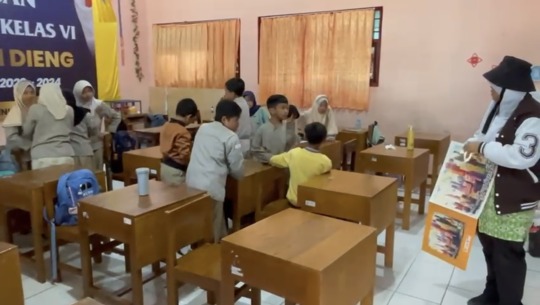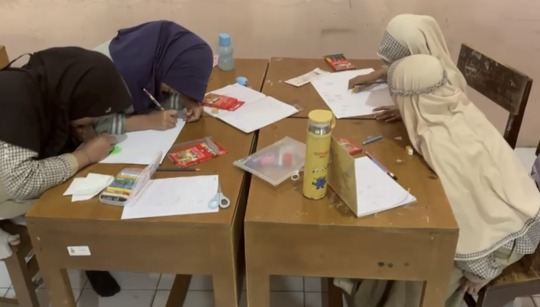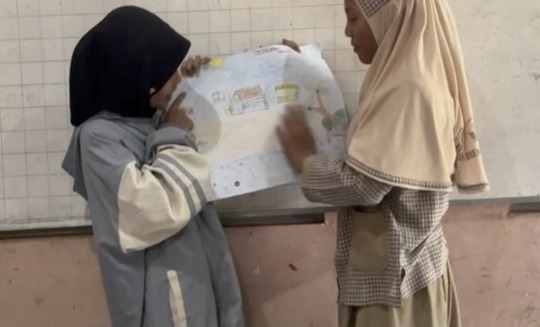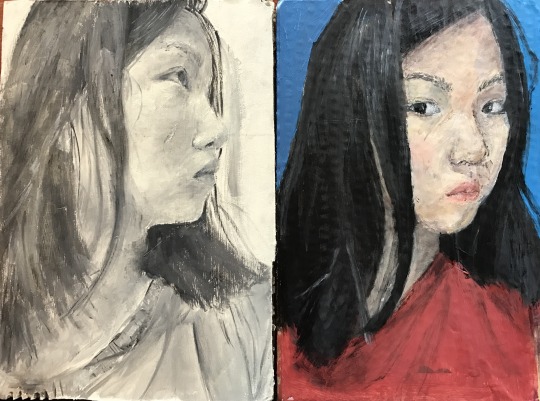#or I could rethink my project make and make something simpler… but I already learned this cool more complex thing if it wasn’t for this bug
Explore tagged Tumblr posts
Text
bugs are the most evil and fucked up things on this planet
#like your own bugs are bad enough but bugs you aren’t responsible for… even worse#especially if you can’t fix them#tbf I’m a bit out of my depth rn (complex particle systems)#but I got the set-up running on an older version but the newer version doesn’t have the same modules#other people apparently got it running so I should probably just ask or dig deeper into forums#or I could rethink my project make and make something simpler… but I already learned this cool more complex thing if it wasn’t for this bug#sina’s rambling#need a new tag for complaining about dev related stuff
28 notes
·
View notes
Text
Teaching about the Environment
.・。.・゜✭・.・✫・゜・。..・。.・゜✭・.・✫・゜・。..・。.・゜゜
In early September my school plans that we have a trip to Dieng to do our project. The project consist that we interact with the locals to do something, example: teaching, playing games and other. So after we were given the list who we will be the same group as we started to plan things out.
For sometime me and my group were having hard time coming up with an idea, some scarp idea we have (but not limited to) are : teaching the local children how to plant potato and tea (we realise how there is little to no place for us to plant it), teaching group Math (I don’t really think my friend like doing that), and renovating the mosques (the other group already thought of that).
After thinking, I come up teaching about the environment to the children. How I come up with this idea is by rethinking our other scarp idea, teaching the local children how to plant potato and tea, and making it more simpler. Other reason why I want to focus on the environment is because the increasing environmental damage in Dieng (such as : Deforestation, water wasting and littering). After getting uprovable by our supervisor we started our planning. Firstly for my Learning outcome, this will be foundation for how i will act and other stuff,
my learning Outcome for this trip are :
1. Identify your own strengths and develop areas for personal growth.
2. Demonstrate that challenges have been undertaken, developing new skills in the process.
3. Demonstrate how to initiate and plan a CAS experience.
5. Demonstrate the skills and recognize the benefits of working collaboratively.
6. Demonstrate engagement with issues of global significance.
Secondly we need to think HOW we going to teach the children, we want to teach 5 grader and because they’re still so young we need to find a way to make our explaination clear and fun. After some discustion we decide we are going to teach them by making poster.
So the idea is we are going to give some brief explanation in the beginning then we devided the children to 3 group that each group have 5 children. After that each of us will guide each group by giving them information while they are making poster.
After they are done we will make them presented their poster to their friends. The group that have the best poster we will give a prize (snack) and after that we will give short quiz, every time a kid answer a question we will give them a prize. This seems a fun idea so we roll with it.
Now time for division tasks and what each person must bring. For me i will be the one teaching some of the children. in the trip i bring the gift for children like note book and sketchbook for our activity.
๋࣭ ⭑⚝๋࣭ ⭑
After few weeks since our trip to Dieng, i can reflect how i feel and how it was. It was really fun though there is some issue like how we don't have enough time so there is some activity that we didn't have time to do ( like giving the short Quiz). Overall i feel like i have improve my communication skills and also my leadership skills (though i didn't get the official title 'leader' but i'm the one that is leading and giving work to my friends).
The children are really lively, they keep having the look of excited while we were explaining and giving them some guidence. I even found one kid that have the same hobby as me (Drawing) and we both discus about drawing and stuff.
Nevertheless, there is some things i feel like we could improve on in the future. The first one our planing, even though we have a good plan but we were having a hard time explaining to children so maybe in the future we could have more discussion on what to do. Secondly tast division, while planing this trip we been told that we need to make an 'essay' on it, in my group who were writing it is unbalance so we need to improve that on the future. Tird i feel like my explaination for the children is lacking and my voice is still not as loud as i want so i can try to work on that.
ᯓ★
For my LO's here are some thing i can make note on while my trip to Dieng :
1. Identify your own strengths and develop areas for personal growth.
I notice i was able to make the children enthusiastic but i keep having hard time to keep up with them
2. Demonstrate that challenges have been undertaken, developing new skills in the process.
Personally i feel like i have improve my communication and leadering skills
3. Demonstrate how to initiate and plan a CAS experience
We were able to make plans how to do our activity (like tast division, what to bring, how to work together)
5. Demonstrate the skills and recognize the benefits of working collaboratively.
We were able to work together from the start until the end. I learned how its beneficial working collaboratively and how it reduse my workload if i work alone
4. Show commitment to and perseverance in CAS experiences.
Doing this have really test my endurance. Our planning have taken few months and balancing my everyday school was tricky at best. In the end we were able to make our time in there as eventful as possible so because of that i am proud
6. Demonstrate engagement with issues of global significance
Our topic is about teaching the children about the environment. We were able to teach them about the environment around them and how to take care of them. We also did teach them how Deforestation, water wasting and littering occurred and what to do.
and that's all
🌻 documetation:






Time taken: August 2024 ~ October 2024
-16/12/2024
0 notes
Text
My Sister

For the portrait project, which also happens to be our last summative unit, we were allowed to either paint ourselves or someone that means a lot to us, as well as show the intangible about them. I chose to draw my older sister, Selina, and expressed the intangible about her.
The process I used to paint the portrait was fairly simple. First, I painted a layer of white acrylic because the canvas I used was a bit dirty. Next, I sketched out my sister and the major ‘doodles’ I wanted to include. Finally, I painted my sister with oil and outlined the doodles first with acrylic and then oil paint. By making my sister realistic and the doodles flat, I could show what is intangible (the invisible) and what is real.
I think I learned a lot during this unit. First, I think I put all of my effort into painting my sister (and it meant a lot more because she’s family). I brought my canvas home every day to work on it at home and I redid my portrait over and over again so I could make it the best I could. I think I’ve learned about using acrylic and oil paint, as well as how to (try to) portray a human with painting.
The intangible aspect about my sister I showed in my painting isn’t just one aspect, it summarizes everything I know about her. The style of the doodles is based on one of the IB exhibition projects she made, and so I think it already says a lot about her; however, the first thing you might notice about the doodles is that it looks like something a teenage girl would doodle in her diary. This is supposed to symbolize that these doodles are her thoughts, her personality, her everything, just like what a diary is supposed to represent. First glance at this painting, and you might think of a glamor shot. This is supposed to show how she seems perfect when you first meet her: charismatic, friendly, extroverted. However, as much as she seems amazing, she really isn’t. The devil and angel on her shoulder, as well as the devil horns and angel halo, represent how she can be both perfect and evil. Another detail I chose to use was how everything is in the clouds, representing how my sister’s head is always in the clouds, dreaming about being the one in a million. The house in the clouds represents how she holds family close to her heart (or head). The trees remind me of how I can always rely on her, that she is a reliable person, but also that she is always growing (she’s changed a lot since she left for university). The fire growing shows she is passionate about the things she loves, that she is a wildfire that blazes forever and ever. However, the fire also shows how she will never stop being zealous about the things she loves, such as music. The phoenix, rising out of the flame, is supposed to show how she can always rise out of the bad, always find a solution. The lighthouse, a symbol of shelter and strength, represents, similarly to the trees, her reliability and how she offers advice when needed. The crescent, blue moon represents who she is, as her name in Chinese, when read aloud, sounds like the word for moon. The blueness, an opposite of the fire, shows that she is cold and distant sometimes, but also symbolizes her love for the color blue, ever since we were young. In conclusion, everything I included in the painting is supposed to symbolize a part of her, a part that only a sister can see.


Stretch and Explore

The major risk I took (I think) during media testing and in the actual project was simply painting in color. It’s easy to paint in black and white because there are only so few shades to choose from, but in color, you have to deal with skin, hair, eyes, mouth, etc., and I think I took a big risk by choosing to paint in color (though most people did painting color). There was a point when I was painting when I just couldn’t figure out what I was doing, and I just hit a really big obstacle and couldn’t get over it. Something big that didn’t work out when painting on the canvas was when I tried to use a fine tip pen to draw the doodles. In hindsight, I could have tried to use a sharpie, but I painted with acrylic and then oil paint.
This project was also especially difficult for me because I kept changing my plans. During the previous projects, I always had a vision of what I wanted my project to turn out like, no matter how early it was into the project. However, when working on this unit, I felt like I had absolutely no idea. It took a lot of brainstorming and thinking and rethinking and redrawing ideas until I finally figured out what I wanted to do.
Observe

By closely looking at other artists portraits and paintings, I was able to figure out what I wanted to do when painting my own portrait. Although I didn’t borrow Derek Gores’ techniques, I really like how he used simpler colors to make other colors stand out (the white flower in her hair). I borrowed my sister’s technique of drawing doodles (the IB exhibition piece) and took inspiration from that, but for the portrait, I think my biggest inspiration was Ben Lustenhouwer because I just love how lifelike his paintings look (especially the eyes). I tried to use the same techniques he used, such as putting a dab of white in the eyes and on the lips.
Express

This is (technically) my final plan because when I drew my original final plan, it was much different than this final plan. The reason why I didn’t draw out my final plan and chose to print out a photograph and draw on top of that was because I decided to change my plan last minute. I think this final plan is my best one yet because it looks more unified than all my other ones.
I chose to express the intangible aspect, as said before, through little doodles that I believe represent my sister. As you can see in my final plan, I included many of those said doodles. I believe, through this painting, I conveyed a personal message that is my sister. The feeling I aimed to convey was almost this child-like feeling, this simple yet complex feeling you get from looking at the painting.
In conclusion, I think this project was a success. I learned more about my own painting style, as well as more about my own sister through asking her questions. My sister’s birthday was about two weeks ago, so when she comes back for the summer, this’ll be my belated birthday present for her!
2 notes
·
View notes
Text
Nobody reads privacy policies – here's how to fix that
http://bit.ly/2fWWlkV
Most people don't know what they're agreeing to. Micolas/Shutterstock.com
Have you ever actually read an app’s privacy policy before clicking to accept the terms? What about reading the privacy policy for the website you visit most often? Have you ever read or even noticed the privacy policy posted in your doctor’s waiting room or your bank’s annual privacy notice when you receive it in the mail?
No? You’re not alone. Most people don’t read them.
People are confronted with terms of service agreements and privacy policies all the time. Regulations requiring these notices aim to ensure that consumers can make informed decisions, but current privacy policies miss the mark. They are surprisingly ineffective at informing consumers, as Rebecca Balebako, Lorrie Cranor and I analyze in a recently published article.
In 2008 a study estimated that it would take 244 hours a year for the typical American internet user to read the privacy policies of all websites he or she visits – and that was before everyone carried smartphones with dozens of apps, before cloud services and before smart home technologies. With our research, my colleagues and I propose a better way to make clearer privacy policies that are easier to follow.
Hard to find, read and comprehend
Even people who do read privacy policies struggle to understand them, because they often require college-level reading skills. Privacy policies frequently cover multiple services offered by a company, resulting in vague statements that make it difficult to find concrete information on what personal information is collected, how it is used and with whom it is shared.
For example, Google’s privacy policy states “We collect information about the services that you use and how you use them, like when you watch a video on YouTube, visit a website that uses our advertising services, or view and interact with our ads and content.” Then it goes on to list examples of information that may be collected. What exactly is collected about users when they use a specific Google product remains unclear.
Privacy policies are also increasingly posted separately from users’ interactions with a system. For instance, websites link to policies at the bottom of pages, mobile apps link to policies in the app store and the privacy policy of your smart speaker or fitness tracker is likely posted somewhere on the company’s website.
Few privacy policies provide consumers with any choices besides not using the service at all. Companies may also change their privacy policies anytime. Not accepting the updated policy – if consumers are even asked to acknowledge the change – may stop your gadget from working or result in termination of the account.
Different purposes
A fundamental issue is that privacy policies serve different functions for consumers, companies and regulators. Companies use a privacy policy to demonstrate compliance with legal and regulatory notice requirements, and to limit liability. Regulators in turn use privacy policies to investigate and enforce compliance with regulations. Consumers’ need for meaningful information they can use to make choices regarding their privacy is thereby often neglected.
As a result, academics, regulators and governments have called for more usable privacy notices and solutions. For instance, Europe’s General Data Protection Regulation, which takes effect in May 2018, imposes strict requirements on privacy notices. Notices must be in “concise, transparent, intelligible and easily accessible form, using clear and plain language.” Most privacy notices today do not meet these requirements.
Focusing on the consumer
The key to turning privacy notices into something useful for consumers is to rethink their purpose. A company’s policy might show compliance with the regulations the firm is bound to follow, but remains impenetrable to a regular reader.
The starting point for developing consumer-friendly privacy notices is to make them relevant to the user’s activity, understandable and actionable. As part of the Usable Privacy Policy Project, my colleagues and I developed a way to make privacy notices more effective.
The first principle is to break up the documents into smaller chunks and deliver them at times that are appropriate for users. Right now, a single multi-page policy might have many sections and paragraphs, each relevant to different services and activities. Yet people who are just casually browsing a website need only a little bit of information about how the site handles their IP addresses, if what they look at is shared with advertisers and if they can opt out of interest-based ads. Those people doesn’t need to know about many other things listed in all-encompassing policies, like the rules associated with subscribing to the site’s email newsletter, nor how the site handles personal or financial information belonging to people who make purchases or donations on the site.
When a person does decide to sign up for email updates or pay for a service through the site, then an additional short privacy notice could tell her the additional information she needs to know. These shorter documents should also offer users meaningful choices about what they want a company to do – or not do – with their data. For instance, a new subscriber might be allowed to choose whether the company can share his email address or other contact information with outside marketing companies by clicking a check box.
Understanding users’ expectations
Notices can be made even simpler if they focus particularly on unexpected or surprising types of data collection or sharing. For instance, in another study, we learned that most people know their fitness tracker counts steps – so they didn’t really need a privacy notice to tell them that. But they did not expect their data to be collected, aggregated and shared with third parties. Customers should be asked for permission to do this, and allowed to restrict sharing or opt out entirely.
Most importantly, companies should test new privacy notices with users, to ensure final versions are understandable and not misleading, and that offered choices are meaningful.
Location request on an iPhone. Screenshot, CC BY-ND
These shorter consumer-friendly privacy notices can easily coexist with traditional privacy policies. This is already starting to happen on mobile devices. Apple and Google, as the two largest smartphone platform providers, introduced just-in-time permission dialogues in 2008 and 2015, respectively. For instance, when a mobile app wants to access the phone’s location or contacts, the phone gives the user the option to say “No.”
Systems like this give consumers usable information and real choices. And they encourage app developers to communicate better with users about privacy. If we can expand this smartphone model to other uses, then everyone could have privacy policies that are clear, easy to understand and with real meaning for both users and software designers.
Florian Schaub receives funding from the National Science Foundation, which funded parts of the discussed research under grant no. CNS-1330596.
0 notes